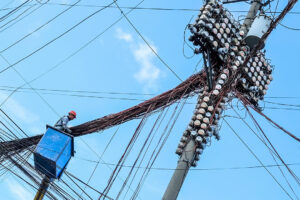




Policy Rate Updates: Double cut finale
 DOWNLOAD
DOWNLOAD

Monthly Economic Update: One for the road
 DOWNLOAD
DOWNLOAD

Inflation Update: Still low, still slow
 DOWNLOAD
DOWNLOAD


PH’s ongoing power crisis is not artificial, says Marcos

Philippine President Ferdinand R. Marcos, Jr. on Monday dispelled fears that the Philippines was experiencing an artificial power crisis after the country’s sole grid operator again raised a yellow alert in the Luzon and Visayas grids, citing an El Niño-driven increase in demand.
“It definitely is not an artificial crisis because the power systems are overloaded,” he told reporters in the southern province of Cotabato, based on a transcript from his office.
“Consumption suddenly increased due to the extreme heat,” he added. “The systems are encountering different problems that’s why we’re closely monitoring them.”
Metro Manila and many parts of the country have recently been experiencing sizzling temperatures, putting a strain on the power supply.
Mr. Marcos said the Philippines was in a “crisis,” vowing to find ways to avoid high electricity costs.
He said the government would further endorse National Grid Corp. of the Philippines (NGCP) projects.
“We’re continuing to monitor the power supply. We’re continuing to monitor the price and we’re continuing to encourage and to endorse all of the programs of NGCP so that they will increase the coverage of their transmission lines all over the country,” he said.
On Monday, yellow alerts were placed on Luzon and the Visayas grids due to thin operating margins as there were still power plants on forced outage, according to the NGCP.
NGCP said in a statement that the Luzon grid was under yellow alert from 2-5 p.m. and 6-11 p.m.
Yellow alerts are issued when the supply available to the grid falls below a safety threshold. If the supply-demand balance deteriorates, a red alert is declared.
The Luzon grid’s available capacity was 14,952 megawatts (MW), while peak demand forecast was 13,893 MW, according to the NGCP.
It said four power plants have been on forced outage since 2023, four between January and March 2024 and 13 this month. One plant is running on a derated capacity. Due to the forced outage, a total of 1,443.3 MW were unavailable to the grid.
On the other hand, the Visayas grid was placed under yellow alert from 1-4 p.m. and 6-8 p.m.
“The extension of the yellow alert in Luzon and the declaration of a yellow alert in the Visayas were due to increase in forecasted demand,” the NGCP said.
Available capacity for the Visayas grid was 2,835 MW while peak demand forecast was 2,596 MW.
“The reason for overloading is not only El Niño-related increase in consumption, but it is also because of unexpected power shutdowns of several power plants connected to the national grid,” Terry L. Ridon, a former lawmaker and a public investment analyst, said in a Facebook Messenger chat.
He said it’s wise for the President to focus on avoiding power cost hikes at this time “because much of the supply will now be sourced from the electricity spot market.”
Mr. Ridon urged the government to consider implementing specific summer protocols or short-term fixed price summer contracts for distribution utilities “to avoid a direct resort to the spot market.”
The Philippines’ energy security is also threatened by the expected depletion of its sole indigenous source of natural gas by 2027.
The Malampaya gas field accounts for at least 40% of electricity needs in the capital region, and economists have warned its depletion might result in 12- to 15-hour rotational brownouts across the main island of Luzon.
Mr. Marcos said his government sees boosting grid connectivity through submarine cables as a solution to power problems across the country.
The Philippines has been seeking to explore oil and gas within its exclusive economic zone in the South China Sea, one of the world’s most important waterways that China claims almost in its entirety, amid the expected Malampaya depletion.
POSSIBLE RATE HIKE
Meanwhile, consumers in Metro Manila could face a hike in power rates in May as higher demand adds pressure to the spot market, according to Manila Electric Co. (Meralco).
“It’s really a measure of supply vis-a-vis the demand. When the demand increases, the pressure is really for prices to go up, particularly in the spot market,” Meralco spokesperson Joe R. Zaldarriaga told reporters on the sidelines of a media briefing.
Mr. Zaldarriaga said rates could go up because prices at the spot market are also high.
For April, typical households in Metro Manila experienced a decrease in their monthly electricity bills for the first time this year due to a sharp drop in generation and transmission charges.
Manuel V. Pangilinan, Meralco’s chairman and chief executive officer, said at a media briefing that the country needs conventional power plants, such as those running on coal, to boost capacity in the grid.
“What the country needs are conventional, dependable power plants so that we don’t get into this crazy situation when one particular large plant is down for its own reasons, and then we’d probably turn to the ILP (Interruptible Load Program),” he said in mixed English and Filipino.
Data from the Department of Energy showed that as of February coal remained as the country’s top source of electricity.
With a share of 43.8%, existing coal plants connected to the grid have a total installed capacity of 12,406 MW.
In 2020, the DoE issued a moratorium on the development of new greenfield coal-fired power plants, as the country sought to reduce its dependence on coal.
Meralco’s controlling stakeholder, Beacon Electric Asset Holdings, Inc., is partly owned by PLDT Inc.
Hastings Holdings, Inc., a unit of PLDT Beneficial Trust Fund subsidiary MediaQuest Holdings, Inc., has an interest in BusinessWorld through the Philippine Star Group, which it controls. — Kyle Aristophere T. Atienza and Sheldeen Joy Talavera
This article originally appeared on bworldonline.com





 By BusinessWorld
By BusinessWorld